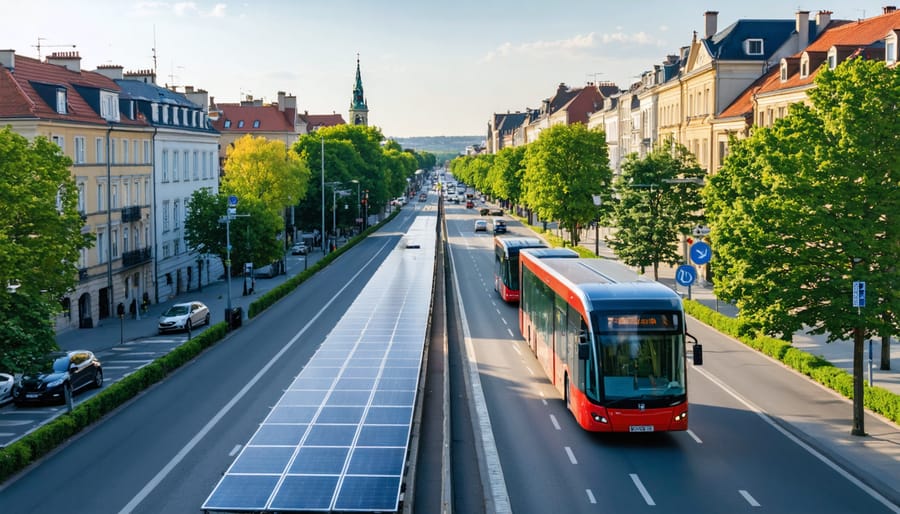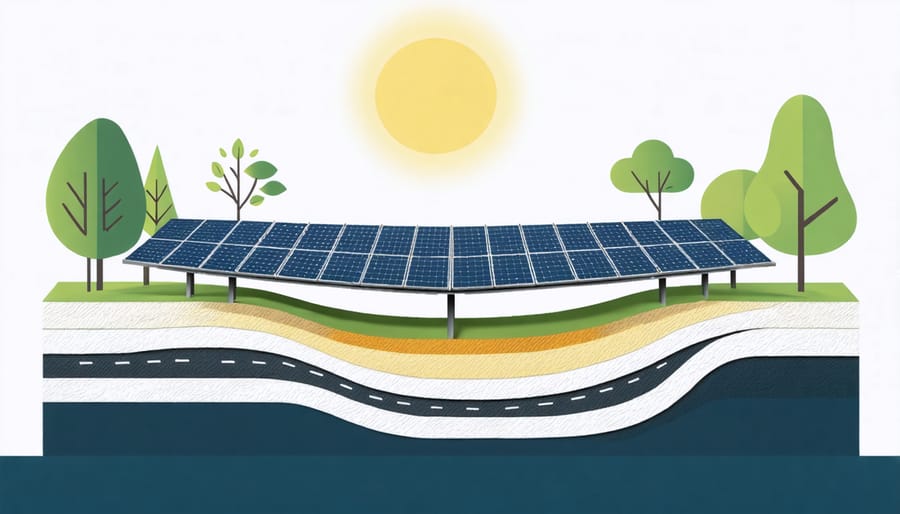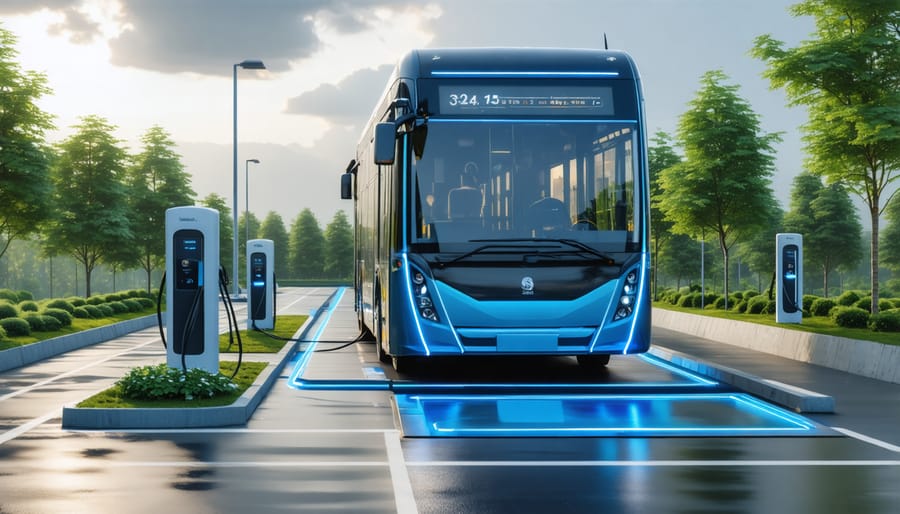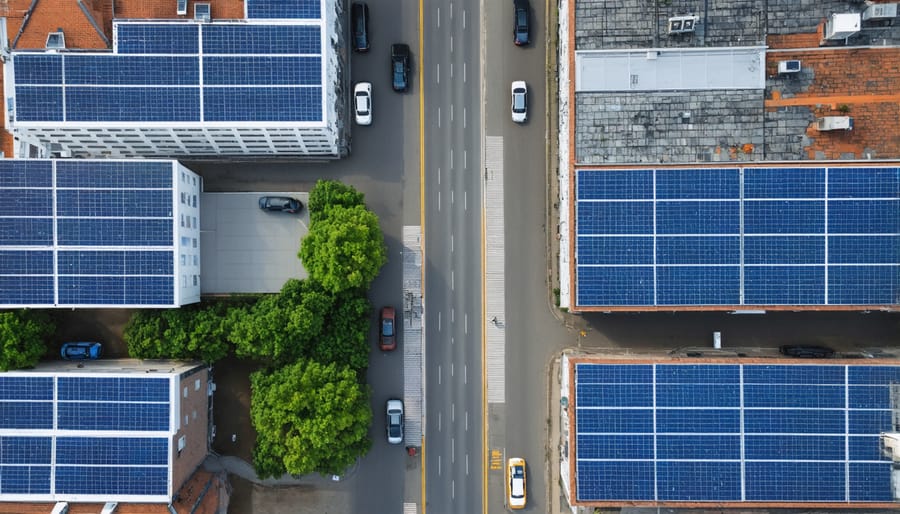Solar-Powered Roads Transform European Public Transit: Here’s How They Work

Solar-powered roads represent one of the most ambitious innovations in sustainable infrastructure, merging transportation networks with clean energy generation. As Europe accelerates its pursuit of renewable energy solutions, these photovoltaic roadways could unlock unprecedented solar potential in Europe, transforming everyday infrastructure into power plants.
Imagine driving on a road that not only supports vehicles but also harvests solar energy to power streetlights, melt snow, and feed electricity back to the grid. This revolutionary technology embeds specially engineered solar panels into road surfaces, protected by tempered glass layers that can withstand the weight of heavy vehicles while capturing solar energy.
French company Wattway pioneered this technology in Normandy, demonstrating how a single kilometer of solar road can power public lighting for a town of 5,000 residents. With European nations seeking innovative solutions to meet ambitious climate goals, solar roads represent a bold step toward maximizing existing infrastructure for renewable energy generation.
The Technology Behind Solar Roads
Photovoltaic Road Panels
Photovoltaic road panels represent a significant advancement in solar technology, specifically engineered to withstand the rigors of vehicle traffic while generating clean energy. These specialized panels feature a three-layer design: a transparent, high-strength surface layer made from tempered glass with anti-slip properties; a middle layer containing solar cells and electronic components; and a base layer that seals and protects the system from moisture and environmental factors.
The panels incorporate innovative silicon-based photovoltaic cells with efficiency ratings between 15-20%, protected by a proprietary combination of resins and polymers. Unlike conventional solar panels, these road-ready versions are designed to distribute weight evenly and resist compression forces up to 80 MPa, equivalent to the weight of heavy goods vehicles.
To maximize energy capture in low-light conditions, the panels utilize advanced light-capturing technology and anti-reflective coatings. They also feature built-in heating elements to prevent snow and ice accumulation, ensuring year-round functionality. Smart sensors integrated within the panels monitor performance, traffic patterns, and surface conditions, enabling real-time system optimization and predictive maintenance.

Energy Storage and Distribution Systems
Solar-powered roads incorporate sophisticated energy storage and distribution systems to ensure consistent power supply even during periods of limited sunlight. The generated electricity is typically stored in advanced lithium-ion battery banks installed beneath or adjacent to the road infrastructure. These storage units are strategically positioned every few kilometres to maintain optimal energy distribution.
The system employs smart grid technology to efficiently manage power flow, directing excess energy to nearby facilities or feeding it back into the local power grid. During peak sunlight hours, the roads can generate more electricity than needed for their own operations, allowing for energy storage or immediate distribution to surrounding buildings, street lights, and electric vehicle charging stations.
In European implementations, the distribution network often integrates with existing municipal power systems through sophisticated inverters and transformers. This integration enables seamless power sharing between the solar road network and conventional power infrastructure. Advanced monitoring systems continuously track energy production, storage levels, and distribution patterns, optimising the entire system’s efficiency while ensuring reliable power supply during various weather conditions and usage scenarios.
Integration with Public Transit Infrastructure

Electric Bus Charging Stations
The integration of solar roads with public transit infrastructure has revolutionized how we power electric bus networks across Europe. These innovative pathways serve as solar-powered charging stations, enabling buses to recharge efficiently while maintaining their regular routes.
In cities like Amsterdam and Paris, solar road segments at bus terminals and designated stops harvest solar energy throughout the day. This energy is stored in sophisticated battery systems integrated beneath the road surface, providing a reliable power source for electric buses during both day and night operations. The charging process occurs seamlessly during scheduled stops, eliminating the need for lengthy charging periods at depots.
Each charging point can generate approximately 15-20 kWh of energy daily, depending on weather conditions and geographical location. This output is sufficient to power an electric bus for several kilometers, significantly reducing the network’s reliance on grid electricity. The system’s smart management technology ensures optimal energy distribution, prioritizing buses based on their routes and battery levels.
The implementation of these solar road charging networks has helped municipal transport authorities reduce their carbon footprint while maintaining reliable service schedules. Cities utilizing this technology report up to 70% reduction in grid power consumption for their electric bus fleets, demonstrating the viable path toward sustainable public transportation.
Transit Station Power Supply
Transit stations equipped with solar-powered road systems benefit from an innovative approach to energy management that extends beyond mere illumination. These integrated power solutions efficiently channel harvested solar energy to support various station operations, creating self-sustaining transit hubs across Europe.
The power distribution system typically prioritises essential station functions, including digital information displays, ticketing machines, and security systems. Advanced energy management systems monitor and regulate power flow, ensuring optimal distribution during peak hours and storing excess energy for use during periods of limited sunlight.
In countries like the Netherlands and Germany, transit authorities have successfully implemented smart energy storage solutions that complement solar road installations. These systems typically incorporate high-capacity batteries or innovative flywheel technology, providing reliable backup power for critical station operations.
The auxiliary systems powered by these installations include platform lighting, ventilation systems, and passenger assistance points. Modern implementations also support charging infrastructure for electric buses and maintenance vehicles, contributing to the broader goal of sustainable public transportation.
Energy monitoring displays installed at various European stations demonstrate real-time power generation and consumption metrics, helping raise public awareness about renewable energy adoption. This transparency has proven particularly effective in garnering community support and encouraging wider implementation of solar transport infrastructure across the continent.
European Implementation Success Stories
Urban Applications
Several European cities have successfully implemented solar-powered road projects, demonstrating the practical viability of this sustainable transportation infrastructure. Amsterdam’s solar bike path, installed in 2014, generates approximately 3,000 kWh of electricity annually, enough to power three households. The path spans 70 meters and has exceeded initial energy production expectations.
In Toulouse, France, a 1-kilometer stretch of solar road installation provides power to nearby street lighting and bus stops. The project, completed in 2018, serves as a proof of concept for urban integration, generating roughly 15,000 kWh yearly while maintaining regular traffic flow.
Stockholm’s pilot program incorporates solar road panels at major intersections, powering traffic signals and electric vehicle charging stations. The system includes smart sensors that monitor traffic patterns and adjust signal timing for optimal energy usage.
These urban applications demonstrate how solar roads can serve multiple functions: generating clean energy, supporting city infrastructure, and advancing smart city initiatives. The success of these implementations has prompted several other European municipalities to plan similar projects, particularly in areas with high pedestrian and cycling traffic.

Rural Transit Connections
Solar-powered roads are revolutionising transportation access in remote European communities, offering sustainable solutions for areas previously underserved by public transit. In Norway’s Nordland region, a 1.2-kilometre solar road stretch connects isolated fishing villages to main transport arteries, generating power for electric buses while ensuring year-round accessibility.
The French Alps have embraced this technology with the installation of solar road panels along mountain routes, providing reliable power for electric shuttle services between remote ski resorts and valley towns. These installations remain functional even under challenging winter conditions, thanks to integrated heating elements that prevent snow accumulation.
Spain’s rural Andalusia region showcases another innovative application, where solar road networks power autonomous electric minibuses connecting remote agricultural communities. The system generates surplus energy during peak sunlight hours, storing it for evening operations and supporting local grid stability.
In rural Sweden, solar road projects have enabled the creation of “green corridors” – sustainable transit routes linking remote communities to larger towns. These corridors feature solar-powered charging stations and smart lighting systems, ensuring continuous service regardless of grid connectivity challenges. This infrastructure has significantly improved mobility options for residents while supporting regional sustainability goals.
Future Prospects and Development
The future of solar-powered roads holds promising developments across Europe, with several innovative projects in the pipeline. Research teams in Germany and the Netherlands are currently developing next-generation photovoltaic materials specifically engineered for road surfaces, promising improved durability and energy conversion efficiency up to 25% higher than current installations.
Smart integration systems are being designed to connect these solar roads with urban infrastructure, enabling real-time energy distribution to nearby buildings and electric vehicle charging stations. In France, plans are underway to expand solar road networks to cover 1,000 kilometres by 2030, incorporating advanced energy storage solutions and intelligent traffic management systems.
Emerging technologies include self-healing surface materials that can repair minor damage automatically, reducing maintenance costs and extending operational lifespan. Scientists are also working on transparent concrete alternatives that could revolutionise how solar cells are integrated into road surfaces while maintaining structural integrity.
The European Union has allocated substantial funding for solar road research and implementation through its Green Deal initiative, supporting pilot projects in multiple member states. These developments are accompanied by improvements in construction techniques that could reduce installation costs by up to 40% over the next five years.
As cities continue to embrace smart infrastructure solutions, solar-powered roads are positioned to play a crucial role in achieving carbon neutrality targets while providing sustainable energy for urban communities.
Solar-powered roads represent a groundbreaking fusion of transportation infrastructure and renewable energy technology, offering European cities a pathway toward more sustainable public transit systems. As demonstrated by pilot projects across the continent, these innovative roadways can generate clean electricity while supporting regular traffic flow, potentially transforming our urban landscapes. The technology’s ability to power nearby street lighting, charging stations, and even public transport systems showcases its versatility in creating self-sustaining transit corridors. While initial implementation costs remain a consideration, the long-term benefits of reduced carbon emissions, decreased energy dependency, and enhanced infrastructure resilience make solar roads an increasingly attractive option for forward-thinking municipalities. As technology advances and installation costs decrease, we can expect to see more European cities embracing this sustainable solution, paving the way for a greener, more efficient public transportation network of the future.
Leave a Reply